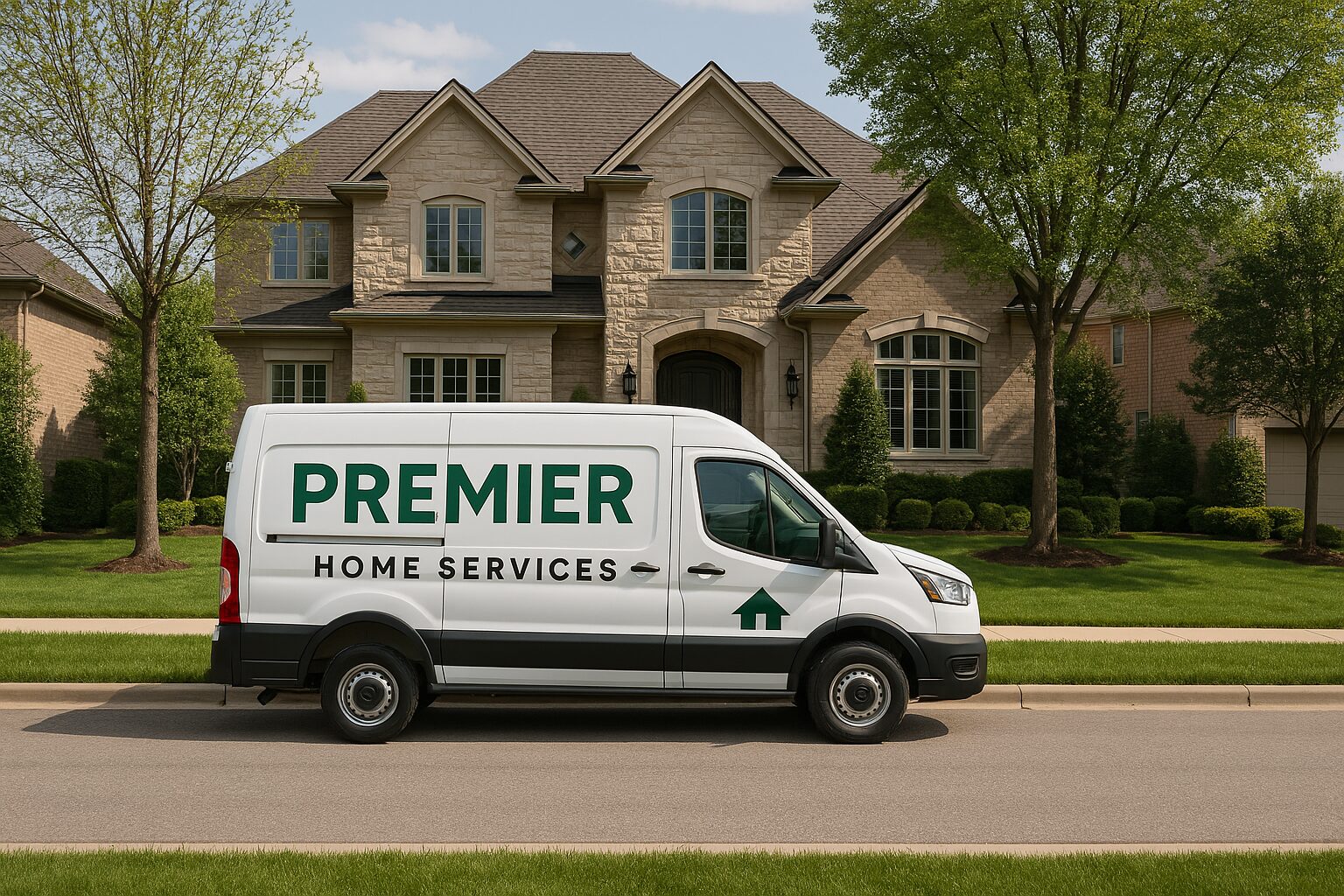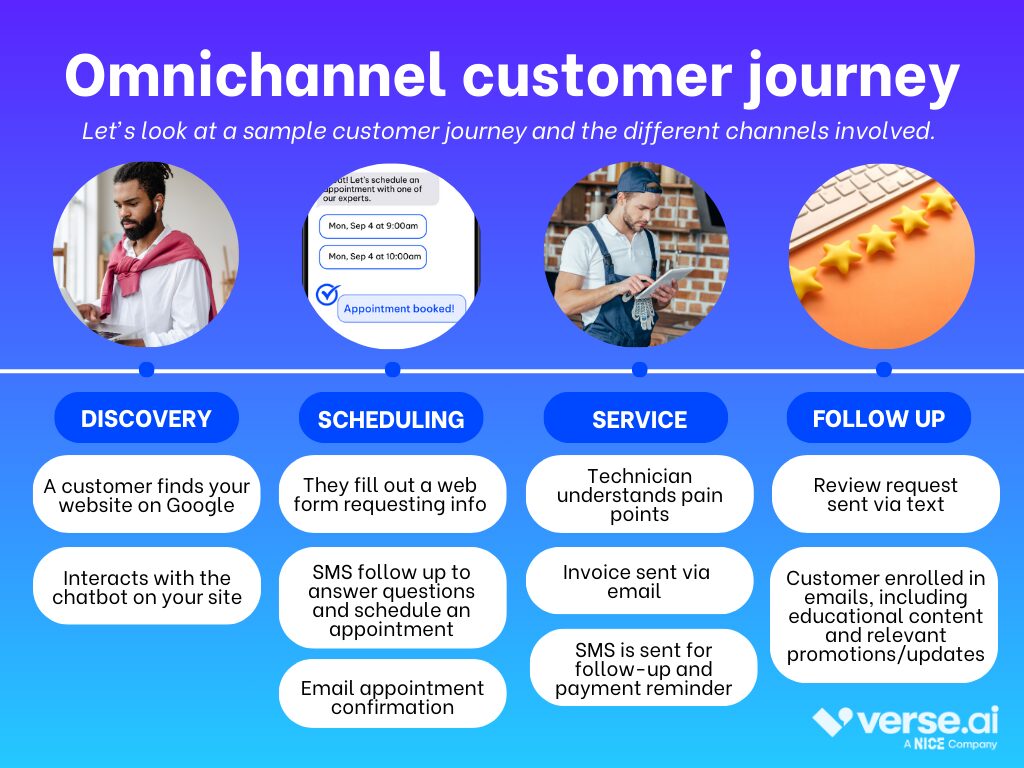Your Guide to Creating an Omnichannel Customer Experience for Home Services
Customers expect more than just great service—they expect it to be fast, seamless, and consistent across every touchpoint.
In fact, 80% of customers value their experience with a company as much as its products or services.
Whether you’re running a home services or home building company, a mortgage business, or a real estate team, the way you communicate with customers has become just as important as the service you provide.
That’s why omnichannel customer experience for home services is so important.
Omnichannel is more than a buzzword—it’s a strategy that helps you meet customers where they are: online, on the phone, via text, or in person.
For industries connected to the home, where trust and timing are everything, delivering a unified experience across channels can be the difference between winning or losing a customer.
In this guide, we’ll break down how to craft an effective omnichannel customer experience for home services companies.
What is omnichannel customer experience?
An omnichannel customer experience is where a business meets customers on all channels in order to create a cohesive customer experience. This includes marketing, sales, and service.
With omnichannel, regardless of the platform or method a customer chooses, the customer experience should be excellent. This includes:
- Consistency across channels
- Fast service and replies
- Integrated messaging throughout the customer journey
Omnichannel customer experience includes:
- Phone calls
- SMS
- Emails
- Social media channels
- In-store or in-person interactions
Omnichannel vs. multichannel
When talking about omnichannel customer experience, multichannel may come up as well.
While both omnichannel and multichannel use multiple channels, the key difference lies in the customer-focused nature of omnichannel.
In multichannel, customers have access to your brand via a variety of channels; however, the channels are not linked, so the experience may be different from channel to channel.
On the other hand, omnichannel is customer-centric, integrating channels in a way that unifies the customer experience.
For example, most companies are currently multichannel: say you have a website, Facebook, and a physical store. However, the experiences between these channels can be inconsistent: maybe the person running Facebook and the store manager aren’t on the same page, and different promotions are happening within each. So when a customer comes into the store, they could become confused.
With omnichannel, these experiences should be consistent: same messaging across channels, and customer-facing teams have updated information.
Why you need omnichannel customer experience for home services
People want fast, consistent communication—whether they’re calling, texting, shopping online, or connecting on social media.
53% of consumers are frustrated by waiting too long for replies when interacting with businesses, and will switch to a competitor if the wait is too long.
As consumers are now using an average of six touchpoints during a purchase decision process, omnichannel is becoming vital for every industry.
For home services, omnichannel is even more important due to the high-touch nature of the industry. Think: scheduling, reminders, technician arrival, payment, follow-up, etc.
When the transition from your website to getting their questions answered to services delivered is seamless, it improves customer satisfaction and retention.
Businesses that implement omnichannel strategies retain 89% of their customers, compared to just 33% for those that don’t.
Adding an omnichannel customer experience strategy can improve:
- Booking rates
- No-show reduction
- Customer satisfaction
- Long-term retention
How omnichannel fits in the home services customer journey
How can your business effectively add omnichannel into a customer journey that is, at times, complex?
Let’s walk through a sample customer journey and how an omnichannel customer experience can fit in.
Discovery
In the discovery phase, a potential customer has just found your business on Google or social media.
For example, a customer finds your website on Google and interacts with a chatbot on your website.
For an omnichannel experience in this phase, the experience on your website and your chatbot should be streamlined, consistent, and easy to navigate.
It should be easy for the customer to find the service they are looking for and quickly get their questions answered.
Scheduling
Say you delivered a great experience and the customer is ready to schedule an appointment. They fill out a form on your website to be contacted.
In an omnichannel example, your business quickly follows up with this lead via SMS (in this example, the lead gave consent to be texted via the form).
Via text, you answer any questions the lead still has and then schedule an appointment at a time that works for them.
The customer then receives an email confirmation about their appointment.
With omnichannel, this entire experience should be fast, streamlined, and consistent from your website, to texting, to appointment booked and confirmed.
Service visit
During the appointment, the in-person technician will understand the customer’s pain points and provide service as requested.
After the appointment, an invoice is sent via email, and an SMS is sent for follow-up and payment reminder.
Follow up and feedback
If the customer is happy with the service, a review request is also sent via text.
The customer is also enrolled in customer emails, which include educational content for home maintenance and relevant promotions and updates.

How to build an omnichannel customer experience for home services
Now that we understand how an omnichannel customer experience for home services works, let’s go over key steps to building one.
- Identify key customer touchpoints. Understand the critical moments in your customer journey to ensure a smooth process within every step, from inquiry to service delivery. Use practical insights from real-life projects to streamline these interactions for every channel involved.
- Choose the right channels. Most home services companies will benefit most from including website chat, SMS, email, phone, and social media into their omnichannel strategy. However, make sure to include the channels that prove most effective for your business.
- Develop consistent messaging. Align content across digital channels that reflects the customer journey. For example, ensure search engine optimization efforts boost online visibility while offering clear instructions such as posting a reliable telephone number.
- Integrate communication tools. For an effective omnichannel experience, your CRM and software should be fully integrated and updated to ensure visibility for every interaction.
- Optimize mobile experiences. Many people research and book exclusively on their phones. Work to optimize mobile platforms to simplify service requests and boost sales, for example, quicker load times and intuitive design. Upgraded mobile interfaces are a must-have for seamless omnichannel experiences.
- Train staff. Align service delivery with the brand’s values and messaging. Practical staff training sessions should focus on communication protocols, troubleshooting common service issues, and improving customer interactions across various channels.
- Automate without sacrificing human touch. Automation for 24/7 communication can support the customer journey at any hour, providing immediate responses. These tools should deliver accurate knowledge, and leave room for human interaction when needed.
- Use the right technology. An omnichannel strategy includes implementing CRM systems, enabling 24/7 support, automating email updates and SMS, engaging via social media, and monitoring customer behavior through analytics.
- Provide educational content. Omnichannel doesn’t end after the sale or service. Home service providers should offer educational resources that help homeowners to navigate their service journeys with confidence and clarity.
- By sharing practical insights and real-life examples for routine home services and preventive care, you can boost customer satisfaction, trust, and loyalty.
- Data and analytics. Use data to monitor and improve your approach. Track omnichannel effectiveness by analyzing customer engagement and conversion rates across omnichannel platforms. Combining data metrics and practical insights from previous projects, make adjustments as needed to close service gaps.
Common omnichannel challenges (and how to overcome them)
In home-related industries, where teams often juggle multiple tools, vendors, and communication channels, building an omnichannel experience isn’t always easy.
Here are some common roadblocks and how to tackle them.
Problem #1: Disconnected systems.
Many teams rely on a patchwork of platforms – sometimes even a CRM that doesn’t sync with anything else. However, this can create a fragmented customer experience and a lot of manual work.
How to fix it:
- Look for platforms that integrate your core communication tools into a single system—or invest in middleware that bridges the gaps. Even small improvements in system integration can reduce missed messages and make life easier for your team.
Problem #2: Staff resistance to new tech.
Your team might be wary of adding another tool to their workflow. Without employee buy-in, an omnichannel strategy can’t work.
How to fix it:
- Involve the team in the decision-making process when buying new tech.
- Offer thorough onboarding and training.
- Show how the tech helps them: fewer missed calls, easier follow-ups, or less time jumping between tools.
- Prioritize tools with intuitive interfaces and solid onboarding support.
Problem #3: Customers receive duplicate or missed messages.
Without coordination, customers may get conflicting messages, including appointment confirmations, or worse—none at all. This can stem from lack of data and visibility, manual work, and human error.
How to fix it:
- When mapping out customer touchpoints, assign communication ownership at each stage. Use automation thoughtfully to send reminders, updates, and follow-ups.
Tools to help home services go omnichannel
Key tools that home services companies will need include:
- CRM. Many home services companies already use a CRM, such as Salesforce or HubSpot, to keep track of customer relationships and data. If you already use a CRM, it’s vital that this system syncs with other software properly for accurate data.
- Email automation. Omnichannel experiences most often include email automation. Email automation platforms like HubSpot, Adobe Marketo, and Mailchimp reduce manual work and help to organize communication.
- Scheduling software. For appointments, you’ll need scheduling software (like Calendly) that works well and syncs with your CRM.
- Website chatbots. Many companies and their customers benefit from 24/7 chatbots. Chatbots like Atlas live on your website and answer common questions or take down customer information so a human can contact them.
- When choosing a chatbot, ensure that it’s advanced enough to answer questions accurately and understand when it cannot answer and should pass to a human.
- SMS automation. As texting has grown in popularity among consumers, SMS automation is becoming more essential. SMS tools such as Verse.ai can meet customers on their smartphones to answer questions, qualify leads, and schedule appointments.
Improving the home services customer journey with omnichannel experiences
In industries like home services, home building, mortgage, and real estate—where trust, timing, and communication are everything—omnichannel represents a huge competitive advantage.
The journey to omnichannel experiences for home services isn’t easy, but it’s worth it.
Start by identifying the highest-impact touchpoints in your customer journey where omnichannel will benefit customers the most. From there, build omnichannel abilities at your own pace with the right tools.
If you’re ready to see what an omnichannel experience could look like for your business, Verse is here to help with SMS automation, omnichannel follow-up, and detailed analytics.
Book a demo today or check out our self-serve demo center to explore how Verse supports home-focused businesses, including mortgage, real estate, home services, and more.


